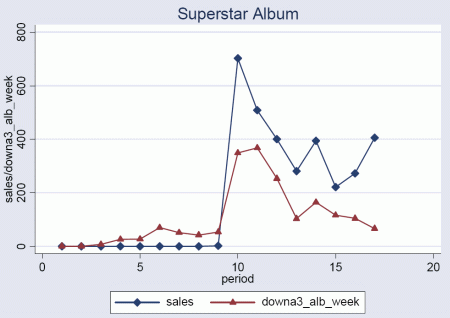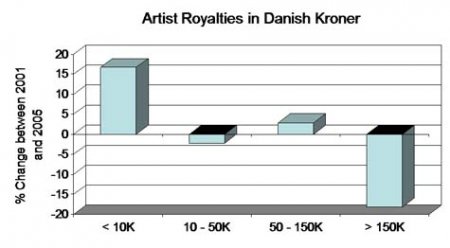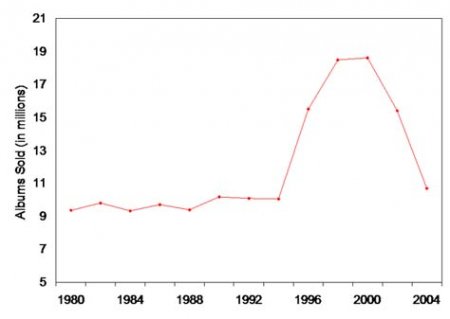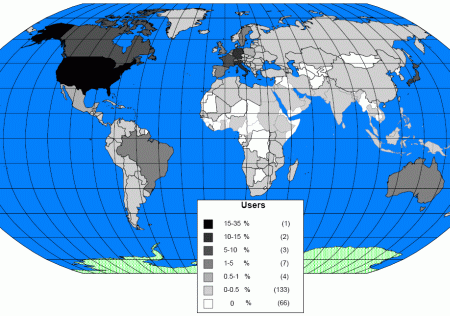Most musicians benefit from piracy
Over the past three years, at least five detailed studies of the impact of P2P networks on the music industry in general and on the profits of musicians in particular have been conducted. Here are the main points with links to sources .
The main thesis is that little-known music groups only win if their work is distributed free of charge on the Internet, whether it be file-sharing networks or social music services such as Last.fm and Pandora . Moreover, the less famous the musician, the greater the benefit he receives from “free PR”. In principle, this was already obvious, but now this thesis has been scientifically proven.
The most complete picture of the influence of P2P on CD sales is given in the work of Oberholzer and Strumpf “The effect of file sharing on record sales and empirical analysis” ( PDF ).
The graph shows the relationship between the number of downloads of files by a popular artist from file-sharing networks (red) and the corresponding number of sales of his album (blue) for the same time periods.

As you can see, the "superstar album" graphics move almost synchronously. The number of downloads is almost equal to the circulation of CDs, and from the 15th week the discrepancy begins: the number of downloads decreases, and the number of album sales grows.
The picture with the distribution of music by a little-known group is completely different. The surge in the popularity of music among pirates is causing an increase in CD sales. As in the case with the "star", the effect is most pronounced since the 15th week of sales.

As another Harvard study ( PDF ) showed , about 75% of all musicians fall into the category of authors and performers who benefit from piracy. Similar conclusions were obtained by Danish colleagues who analyzed the amount of royalties paid to musicians in 2001-2005. The graph shows that during this time, low-paid musicians began to earn more, and for “stars” the fees decreased by 17%.

But, since the “stars” have the total circulation of albums more than all the other musicians combined, the total sales of CDs in the world are also declining, and record companies are losing profits. For this reason, the RIAA and others make such a fuss. A graph published by Danish researchers shows that the number of CDs sold in Denmark began to decline sharply in 2001, and this process continues to this day.

The same picture is observed not only in Denmark, but also in other countries where file-sharing networks are very popular. The map below shows in which countries P2P-program users live (by the number of logins). These are mainly America and the countries of Western Europe.

It is here, in the USA and Western Europe, that record companies lose most of their profits, while in the “gray” countries, which include all the CIS countries, sales of music CDs and RIAA profits may even grow.
One way or another, but thanks to the Internet, the music industry has clearly received a new impetus to development. Unique social services have appeared, with the help of which listeners can analyze their own musical tastes and find new artists for themselves. The Internet and social networks have become a platform where talent will certainly be noticed. Superfluous on this holiday of life are only music labels that are feverishly looking for a way out of the crisis .
The main thesis is that little-known music groups only win if their work is distributed free of charge on the Internet, whether it be file-sharing networks or social music services such as Last.fm and Pandora . Moreover, the less famous the musician, the greater the benefit he receives from “free PR”. In principle, this was already obvious, but now this thesis has been scientifically proven.
The most complete picture of the influence of P2P on CD sales is given in the work of Oberholzer and Strumpf “The effect of file sharing on record sales and empirical analysis” ( PDF ).
The graph shows the relationship between the number of downloads of files by a popular artist from file-sharing networks (red) and the corresponding number of sales of his album (blue) for the same time periods.

As you can see, the "superstar album" graphics move almost synchronously. The number of downloads is almost equal to the circulation of CDs, and from the 15th week the discrepancy begins: the number of downloads decreases, and the number of album sales grows.
The picture with the distribution of music by a little-known group is completely different. The surge in the popularity of music among pirates is causing an increase in CD sales. As in the case with the "star", the effect is most pronounced since the 15th week of sales.

As another Harvard study ( PDF ) showed , about 75% of all musicians fall into the category of authors and performers who benefit from piracy. Similar conclusions were obtained by Danish colleagues who analyzed the amount of royalties paid to musicians in 2001-2005. The graph shows that during this time, low-paid musicians began to earn more, and for “stars” the fees decreased by 17%.

But, since the “stars” have the total circulation of albums more than all the other musicians combined, the total sales of CDs in the world are also declining, and record companies are losing profits. For this reason, the RIAA and others make such a fuss. A graph published by Danish researchers shows that the number of CDs sold in Denmark began to decline sharply in 2001, and this process continues to this day.

The same picture is observed not only in Denmark, but also in other countries where file-sharing networks are very popular. The map below shows in which countries P2P-program users live (by the number of logins). These are mainly America and the countries of Western Europe.

It is here, in the USA and Western Europe, that record companies lose most of their profits, while in the “gray” countries, which include all the CIS countries, sales of music CDs and RIAA profits may even grow.
One way or another, but thanks to the Internet, the music industry has clearly received a new impetus to development. Unique social services have appeared, with the help of which listeners can analyze their own musical tastes and find new artists for themselves. The Internet and social networks have become a platform where talent will certainly be noticed. Superfluous on this holiday of life are only music labels that are feverishly looking for a way out of the crisis .
